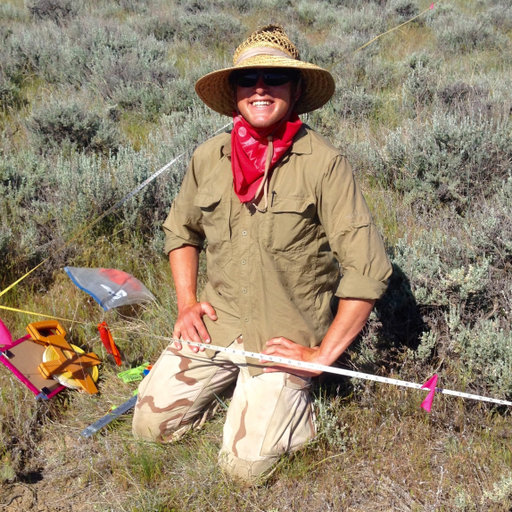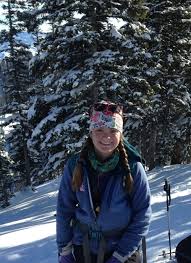Damman Award Winners
2023
Zach Gold1, Adam F. Pellegrini2, Tyler K. Refsland3, Romina Andrioli4, Marlin Bowles5, et al. (1) Princeton University, (2) University of Cambridge, (3) Universidad Nacional del Sur, Argentina, (4) Michigan State University, (5) The Morton Arboretum, …
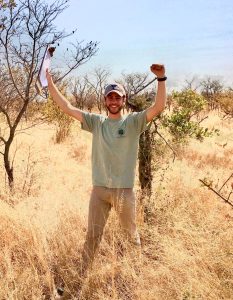
Zach Gold, Ecology & Evolutionary Biology, Princeton University
Herbaceous vegetation responses to experimental fire in savannas and forests.
Abstract: Fire is an important process in savanna as well as forest ecosystems, but its effects on herbaceous vegetation across biomes remain unelucidated. In theory, fire-vegetation feedbacks maintain the vegetation structure of both savannas and forests. In savannas, a continuous layer of highly flammable herbaceous vegetation promotes frequent fires, which inhibit the maturation of juvenile trees. Meanwhile, tree cover in forests inhibits herbaceous vegetation accumulation, thereby limiting fire spread and maintaining the closed canopy. Accordingly, vegetation responses to prescribed fires should depend on the initial condition of the system as either a savanna or forest. Excluding fire in savannas should result in a decrease in herbaceous vegetation due to increased shading from woody vegetation that has been released from fire-induced topkill. In contrast, introducing more frequent fires into forests should induce weaker responses than in savannas because mild surface fires are insufficient to affect mature trees. Work at individual sites provides patchy support for these hypotheses, but the relative magnitude of responses is unclear and insights across studies are further obscured by differences in climatic factors. We synthesized results across studies to ask whether savanna herbaceous vegetation has greater responses to changes in fire frequency, what components of the herbaceous vegetation layer (e.g. grass vs. forbs, C3 vs. C4 plants, etc.) drive responses to fire, and if responses depend on climatic factors.
We examined herbaceous vegetation responses to experimental fire at 30 sites spanning four continents. Across a variety of metrics and climates, herbaceous vegetation generally increased in abundance where fire was applied. Biome had the strongest effect on the response of herbaceous vegetation to fire, with an estimated 4.8 (±0.4) times larger herbaceous vegetation response to fire in savannas than in forests. In particular, grass cover decreased with fire exclusion in savannas, largely via decreases in C4 grass cover, whereas changes in fire frequency had a relatively weak effect on grass cover in forests. Climate also mattered: for every additional 100mm in mean annual precipitation, the estimated response of herbaceous abundance to fire was 20 ± 3.9% larger, indicating that herbaceous vegetation in wetter sites was more responsive to fire. Responses were also larger in less seasonal and/or in cooler sites. These differential responses underscore the importance of fire for maintaining the vegetation structure of savannas and forests. Managed fire is important for conserving open savanna vegetation structure and preventing woody encroachment without necessarily leading to savannization in forests.
2022 (20th Anniversary of the Ton Damman Award!)
L. McKinley Nevins1, Robert J. Smith2, and Jenny Zambrano1. (1) School of Biological Sciences, Washington State University, WA, (2) Air Resource Management Program, USDA Forest Service, Washington, DC.
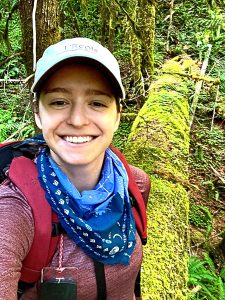
L. McKinley Nevins, School of Biological Sciences, Washington State University.
Tree demographic and neighborhood responses to regional environmental gradients of the northwestern United States.
Background/Question/Methods: Documenting how vegetation varies across large environmental gradients is foundational to understanding long-term persistence of forest systems under future climate conditions and disturbance regimes. Studies of forest communities frequently include only abiotic factors, failing to account for plant-plant biotic interactions that can have significant impacts on demographic rates. We combined data on two prominent environmental gradients, climatic moisture deficit and fire probability, with modelled tree functional neighborhoods, which determine the effects that close neighbors have on a focal tree, to assess variation in survival and growth of 56 of the most abundant tree species in the northwestern US. We asked two main questions: 1) How does functional neighborhood dissimilarity vary with environmental gradients? and 2) How does tree demography vary with the combined effects of environmental gradients and functional neighborhood? We expected functional neighborhoods to become more diverse as environmental stress increased, and to observe increased survival and growth in moist areas with lower fire probability and in more-diverse functional neighborhoods. Overall, less-diverse functional neighborhoods might exacerbate the effects of environmental stress, potentially through reduced strategies for trees to cope with novel conditions and increased competition for resources.
Results/Conclusions: We found that functional neighborhoods changed along the environmental gradients, with a shift from less diverse to more diverse neighborhoods as stress increased. For many species, we observed opposing effects of moisture deficit and fire probability on their demographic responses. Our results suggest substantial species variation in survival and growth responses to the combined effects of environmental variability and functional neighborhoods. In sum, our findings support that environmental variation and biotic interactions jointly determine tree demography. Results of this study offer a different perspective of tree species responses to variable environmental conditions necessary to better anticipate responses to future climate and disturbance changes.
2021
Rachel A Reeb, Mason Heberling, and Sara Kuebbing, Biological Sciences, University of Pittsburgh, Pittsburgh, PA.

Rachel Reeb, Biological Sciences, University of Pittsburgh.
Phenological timing and sensitivity to climate differs between the native and introduced range of an invasive plant species.
Background/Question/Methods: A critical limitation in the forecasting of plant phenological responses to climate change is that we lack knowledge of whether populations of the same species—particularly those whose ranges span multiple continents—have similar phenological sensitivity to warming temperatures. Phenological sensitivity has the potential to vary spatially for many reasons, including local adaptation, drift, and plasticity. We investigate whether the phenological timing and climate sensitivity of an invasive plant, garlic mustard (Alliaria petiolata), differed between its native range in Eurasia and introduced range in North America. We define sensitivity as the number of days a plant delays or advances its phenology per unit change in a climate factor. We used 4,890 research-grade iNaturalist observations of A. petiolata from 2017 – 2019. For each observation image, we recorded the plant’s reproductive phenological stage (budding, flowering, or fruiting), the julian date, and the geographic coordinates. We paired each observation with gridded climatic data from the global Climatic Research Unit (CRU) Time Series. We averaged monthly winter (December – February) temperature and precipitation values for each observation, then used a linear model to examine the effects of mean winter temperature, precipitation (log transformed), and continent of collection (Eurasia or North America) on phenological date.
Results/Conclusions: The phenological timing of A. petiolata was earlier in its introduced range than the home range for the flowering (2.99 days ± 0.64 s.e.) and fruiting (3.19 days ± 0.64 s.e) stages. In addition, A. petiolata was 2 times more sensitive to changes in winter temperature in the introduced range, advancing its reproductive phenology by -1.37 days/ °C (±0.08 s.e.) in Eurasia and -2.68 days / °C (±0.09 s.e.) in North America. By contrast, A. petiolata was less sensitive to changes in winter precipitation in the introduced range, delaying its reproductive phenology by +0.51 days / 10% increase in precipitation in Eurasia and +0.13 days / 10% increase in precipitation in North America. We found the phenology and climate sensitivity of A. petiolata differed between the plant’s native and introduced range, suggesting that populations within each continent will continue to diverge phenologically as the climate warms. We predict that increases in winter temperature will advance the reproductive phenology of A. petiolata to a greater degree within in its introduced range than its native range. However, these effects may also be counteracted by regional changes in rainfall due to climate change, which is predicted to differentially effect North America and Eurasia.
2020
Madelon Case1,2, Benjamin Wigley3,4, Corli Wigley-Coetsee4,5, and Carla Staver1. (1) Yale University, (2) University of Oregon; (3) Sapienza University of Rome, (4) Nelson Mandela University, (5) South African National Parks.
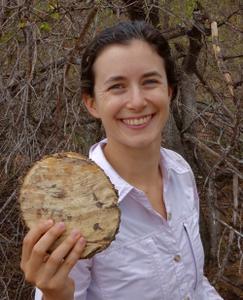
Madelon Case, Yale University and University of Oregon.
Drought vulnerability and long-term impacts in African savanna woody communities.
Background/Question/Methods: Droughts are expected to increase in frequency and severity around the world, with potentially major consequences for vegetation. In tropical and subtropical savannas, little is known about the susceptibility of the tree layer to drought-induced mortality, nor the potential long-term consequences of drought for woody composition and function. Of particular interest is how drought may intersect with other ongoing patterns of vegetation change, such as woody encroachment (a widely observed phenomenon of increasing woody biomass and cover in grassy ecosystems); depending on the drought sensitivity of woody encroachers, drought could either mitigate or accelerate encroachment. A severe drought in South Africa in 2014-2016 provided a rare opportunity to observe savanna vegetation responses over multiple years and answer key questions about variation among tree species in drought sensitivity. Here, we combine results from four years of post-drought tree monitoring in Kruger National Park, South Africa with an analysis of key functional traits distinguishing the most drought-sensitive and drought-resistant species. We also examine how these traits relate to woody encroachment propensity, and use vegetation survey data and historical rainfall maps to study how the frequency of past droughts has influenced the distribution of a dominant woody-encroaching species (Dichrostachys cinerea).
Results/Conclusions: Following the 2014-2016 severe drought in Kruger National Park, we observed high rates of tree mortality and overall declines in tree densities, followed by multiple years of slow recovery. Species varied widely in their responses, with some species much more sensitive than others. The most drought-sensitive species were characterized overall by lower investments in non-structural carbohydrates and polyphenols, higher rates of root-suckering, and higher wood density. The same suite of traits also distinguished woody-encroaching species, which were over-represented among drought-sensitive species, suggesting a potential trade-off between drought resistance and rapid proliferation. The most dramatic example of this was in Dichrostachys cinerea, a widespread woody encroacher that suffered high rates of drought-induced mortality. We also found that D. cinerea distributions throughout Kruger were limited both by mean annual rainfall and by the frequency of past droughts, suggesting that slow rates of post-drought population recovery can have long-lasting impacts on the extent and abundance of this otherwise highly successful species. As droughts increase in frequency and severity, they will increasingly shape the composition of savanna woody communities, and could potentially make woody encroachment by drought-sensitive species easier to control.
2019
Michelle Talal1 and Mary Santelmann2. (1) Environmental Sciences Graduate Program, Oregon State University, Corvallis, OR; (2) Water Resources Graduate Program, Oregon State University, Corvallis, OR.
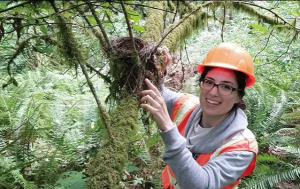
Michelle Talal, Environmental Sciences Graduate Program, Oregon State University.
Plant community composition and biodiversity patterns in urban parks of Portland, Oregon.
Background/Question/Methods: Urban parks are biodiversity hotspots and are integral components of green infrastructure in urban areas. A variety of land use practices and environmental factors affect urban park biodiversity and vegetation structure, composition, and ecological function, but few studies compare plant taxonomic composition, structural complexity, and species traits across different types of urban green spaces. The purpose of this study was to better understand the relationships between plant community composition, structural patterns, biodiversity, and environmental and species traits by using a standardized data collection method across different types of urban parks in Portland, Oregon. We examined the potential ways that different types of urban parks preserve native species and/or harbor non-native and invasive species. We used a stratified random sampling design to select 15 parks of different types based on use: 1) recreational-active use parks, 2) natural-passive use parks, and 3) multi-use parks. Within each of the selected parks, data were collected in five 400-m2 square plots. One-way analysis of variance was used to test hypotheses about variables associated with diversity. Multivariate analyses such as ordinations, cluster analysis, and hilltop plots were used to explore vegetation composition data and associations of different species assemblages with environmental variables.
Results/Conclusions: We found a total of 178 plant species belonging to 141 genera and 65 families. The largest number of native and invasive species were herbaceous, while most non-native species were saplings/shrubs. Statistically-significant differences in species richness and biodiversity indices were found between different park types. More native species were found in natural-passive use parks than other park types, more non-native species are found in multi-use parks than the other park types, and more invasive species were found in natural passive-use parks than in recreational-active use parks. Attributes such as wetland habitat, natural-passive use park type, steep slopes, native species origin, and vine and tree forms were those most strongly correlated with the ordination, indicating that these attributes exert the strongest influence on species abundance and distribution with Portland’s urban parks. The findings can assist park managers in aims to promote native species cover, reduce invasive species presence, or achieve their other goals for urban parks. Improved management of plant community composition, structure, and cover within all park types has the potential to improve the habitat quality for animals, microorganisms, and fungi, as well as a range of economic, health, social, and cultural benefits for people who live in urban areas.
2018
Samuel E. Jordan1, Kyle A. Palmquist2, John B. Bradford3 and William K. Lauenroth2, (1)School of Forestry and Environmental Studies, Yale University, New Haven, CT, (2)Department of Botany, University of Wyoming, Laramie, WY, (3)Southwest Biological Science Center, U.S. Geological Survey, Flagstaff, AZ.
Soil water availability shapes plant species richness in big sagebrush communities
Background/Question/Methods: Plant communities are controlled by multiple, interacting ecological drivers that influence the frequency, abundance, and diversity of species. For many dryland ecosystems, soil water availability is the primary limiting resource that influences structure, function, and composition. We used intensive field sampling coupled with soil water balance modeling to explore the relative importance of biotic and abiotic variables on plant species richness at the landscape scale in dryland plant communities. We asked 1) what are the patterns of total and functional type richness? and 2) what are the relationships between total and functional type richness and macroclimatic, ecohydrological, and biotic conditions? We estimated species richness at multiple spatial scales in 48 dryland plant communities dominated by big sagebrush (Artemisia tridentata) and quantified richness and variability for total species and functional types at each spatial scale. We used multiple regression and model selection to determine whether climatic means, multiple metrics of soil moisture from a soil water balance model (SOILWAT2), or site-specific soil and vegetation variables were more related to total and functional type richness. With our top models, we used variance partitioning to determine the unique variability in total and functional type richness.
Results/Conclusions: Richness was most variable at the smallest spatial scale (CV = 71%) and least variable at the largest spatial scale (CV = 10%). The three major functional types had almost equal variability at the 100 m2 spatial scale (grass CV = 12%, forb CV = 16%, shrub CV = 17%), but had unequal variability at the smallest spatial scale, 0.01m2 (grass CV = 83%, forb CV = 139%, shrub CV = 249%). We found that at the largest sampling scale (1000 m2), richness was more strongly related to ecohydrological variables than climate or biotic variables. Variance partitioning revealed that a large portion of variability in total community (~54%), grass (~40%), forb (~47%), and shrub (~25%) richness was explained by soil water variables. Including ecohydrological, macroclimatic, and biotic predictors in the same model did not substantially increase explanatory power beyond ecohydrological variables alone. Our results highlight the variability of species richness within plant communities that share a dominant species. Additionally, our findings reinforce the potentially greater explanatory power of soil water variables over climatic conditions in dryland plant communities, and offer insight as to which aspects of soil moisture may be most influential to species richness in big sagebrush communities.
2018 International (IAVS)
A. E. Stears1, D. Blumenthal2, K. Wilcox2, J. Kray2, T. Ocheltree3, P. Adler4, D. Laughlin1; 1Department of Botany, University of Wyoming; 2USDA/Agricultural Research Service; 3Department of Forestry and Rangeland Stewardship, Colorado State University; 4Department of Wildland Resources and the Ecology Center, Utah State University.
Leaf osmotic potential affects survival probability in response to inter-annual climatic variation in a semi-arid short-grass steppe in northern Colorado
Abstract: Global climate change increases the likelihood of extreme weather events and may exacerbate variability in inter-annual climate. This heightened variation in weather will likely affect biodiversity and ecosystem function, but we currently lack a general understanding for predicting how plant communities will respond to changing environmental conditions. Previous work has characterized broad relationships between plant traits and regional climate, but this work has ignored the population dynamics that lead to observable changes in community structure. The goal of our project is to quantify how plant functional traits mediate demographic responses to inter-annual variation in climate. We synthesized 15 years of demographic data from permanent plots, new measurements of functional traits, and records of annual climate variability in a short-grass steppe ecosystem in northern Colorado (COSGS). We have calculated the Standardized Precipitation Index (SPI) for each growing season as a measure of drought intensity. Here we focus on leaf osmotic potential, a measure of solute concentration in fully hydrated leaves that is highly correlated to turgor loss point, which is the water concentration at which a leaf begins to wilt. This trait is, in turn, highly predictive of drought sensitivity, such that plants with more negative leaf osmotic potential are more drought tolerant. We fit a Generalized Linear Model to determine whether leaf osmotic potential impacts the probability that a species will survive following dry years or excessively wet growing seasons.We found that survival was influenced by a significant interaction between leaf osmotic potential and SPI (P = 0.018). In dry years (low SPI values), individuals with low (more negative) leaf osmotic potential had higher survival rates, whereas in wet years (high SPI values), individuals with higher (less negative) leaf osmotic potential were more likely to survive to the next year. Our long term goal is to determine which multidimensional trait combinations optimize survival probability in dry years. By focusing on traits that can be measured across species, trait-based models allow us to discern relationships between traits and environmental conditions that can be generalized across ecosystems much more easily than species-based models. The relationships we quantify with our models will be more easily transferrable across ecosystems, allowing us to predict how climate change will affect ecosystem productivity and community biodiversity.
2017
Rebecca Barak1, Eric Lonsdorf2, and Daniel J. Larkin3. (1)Plant Science and Conservation, Chicago Botanic Garden, Glencoe, IL; (2) Natural Capital Project, University of Minnesota, Saint Paul, MN; (3) Fisheries, Wildlife, and Conservation Biology, University of Minnesota, St. Paul, MN.

Rebecca Barak, Plant Science and Conservation, Chicago Botanic Garden.
Seeing the prairie through the seeds: Seed mix design for restoration of biodiversity in the tallgrass prairie
Background/Question/Methods: Ecological restoration can be viewed as guided community assembly, with seed mixes serving as inputs to build realized plant communities. Commercially available seed mixes are an important tool for restoring degraded habitats, such as tallgrass prairie, one of the most endangered habitats on earth. However, little is known about how commercial mixes compare to existing remnant and restored plant communities in terms of species composition and diversity. Using data from companies across the Midwestern United States, we quantified biodiversity of commercially available mixes, and compared these diversity measures to remnant and restored tallgrass prairie plant communities. We analyzed multiple facets of biodiversity, including species richness, coefficient of conservatism, bloom-time coverage (phenological diversity), and the degree of evolutionary relatedness between species (phylogenetic diversity). Each of these components of diversity contributes to important ecosystem functions, and therefore, analyzing multiple diversity measures allows us to draw connections between mixes and potential ecosystem functions of their resultant prairies. We also studied whether seed mix price is predictive of diversity. Lastly, we used machine learning to design seed mixes that meet multiple biodiversity objectives simultaneously, at realistic price points.
Results/Conclusions: In all, we studied 67 seed mixes from 14 companies, comprised of 215 species from 36 families. Richness of restored mixes ranged from 4-91 species (mean 34 spp.). Commercial seed mixes were less diverse than remnant prairies in terms of native species richness, and phylogenetic diversity (MPD), but did not differ from restored prairies. On the other hand, commercial seed mixes had higher mean coefficients of conservatism than both remnant and restored prairies. In addition, analysis of seed mix cost and diversity metrics showed that there are greater ecological returns with increasing financial investment. That is, more-expensive mixes had higher taxonomic diversity, conservatism, and phylogenetic diversity. Designed seed mixes were constrained by the commercial availability of species and/or groups in the same way that typical mixes would be (i.e., relatively few spring blooming prairie species are commercially available, regardless of cost, therefore bloom-time coverage of designed mixes was constrained). Based on our results, we propose a tool to aid in species selection for restoration under multiple biodiversity objectives and cost constraints.
2016

Nikunj Goel, Yale University and Indian Institute of Science, Bangalore, India.
Nikunj Goel1,2 and A. Carla Staver1 . (1) Ecology and Evolutionary Biology, Yale University, New Haven, CT. (2) Vishwesha Guttal, Centre for Ecological sciences, Indian Institute of Science, Bangalore, India.
Spatiotemporal dynamics of savanna-forest distribution
Background/Question/Methods: Recent empirical studies have shown that savanna and forest are the two alternative biome states of global vegetation distribution. This idea is well supported by current theoretical models which show that nonlinear feedbacks between fire and grass can lead to bistability in the system. However, these models cannot explain certain empirical observations of savanna-forest distribution such as spatial aggregation of savanna and forest. In other words, a savanna patch is more likely to be found near a neighboring savanna patch and a forest patch with a neighboring forest patch, with a distinct boundary (ecotone) seperating the two vegetations. This is in contrast to our current theoretical understanding of bistable models, which predict a sporadic distribution of savanna and forest patches (null expectation) in the bistable region. This suggest that there might be a neigbour dependent effects (spatial interactions) on the distribution of savanna and forest, hitherto neglected in the theoretical literature. In this work we build a spatial version of the bistable model to study the effects of saptial interactions on the distribution of savanna and forest, using theoretical concepts developed in species invasion and phase transitions in physics.
Results/Conclusions: We show that local spatial interactions coupled with a large-scale spatial gradient of rainfall can lead to spatial clustering of savanna and forest, with a stable savanna-forest boundary. Furthermore, the equilibrium position of the boundary is determined by a particular rainfall value, which we refer to as Maxwell rainfall, and the geomerical shape of this rainfall contour. Our model also suggests that spatial interactions can erode the threshold point behavior of the system, resulting in reversible biome transition with no hysteresis. This may have huge ecological and management implications as there is a growing fear among scientists that rapidly changing climate, increasing draught frequencies, deforestation, land use change and other anthropogenic activities may result in abrupt and irreversible transitions between savanna and forest. Using empirical data from Africa we show that the curvature of rainfall contours may result in a non-deterministic relationship between vegetation and rainfall, which previously was thought a consequence of hysteresis.
2015
Daijiang Li1, Anthony R. Ives2, Ricardo Kriebel3, Ken Cameron3, Ken Sytsma3, Thomas J. Givnish3, Donald M. Waller3. (1) Wildlife Ecology and Conservation, University of Florida, Gainesville, FL; (2) Zoology, University of Wisconsin-Madison, Madison, WI; (3) Botany, University of Wisconsin, Madison, WI.
Pine barrens in central Wisconsin still phylogenetically clustered after 54 years of fire suppression
Background/Question/Methods: Fire suppression has greatly changed the species diversity and composition of plant communities. Its effects on phylogenetic community structure, however, are largely unknown. To study these effects, we compared 1958 survey data to 2012 resurvey data from the same 30 pine barrens sites in central Wisconsin not burned since the 1930s. We built a phylogeny for 177 taxa found at these sites using sequence data from two plastid ‘barcode’ loci (rbcL and matK). We also measured several key functional traits for most of species. We then applied phylogenetic generalized linear mixed models (PGLMMs) to identify phylogenetic patterns as well as underlying mechanisms involving environmental factors and species traits of these communities in both 1958 and 2012. Specifically, we tested (1) whether communities show phylogenetic attraction (i.e., closely related species are more likely to co-occur) or phylogenetic repulsion; (2) whether phylogenetic structure can be explained by environmental variables, especially canopy cover that increased between 1958 and 2012; and (3) whether functional traits can explain species abundance patterns better than phylogeny.
Results/Conclusions: These pine barrens communities showed very strong phylogenetic attraction in both 1958 and 2012, according to either null models or PGLMMs. Species responded individually to environmental variables and these different responses were independent of phylogeny. Therefore, the observed phylogenetic attraction cannot be explained by the environmental variables we measured. Similarly, sites selected different species based on their functional traits. However, including the effects of traits only explained a fraction of the phylogenetic attraction, even though most functional traits in our study showed strong phylogenetic signal. Our results suggest that environmental filtering was a dominant driver of these communities in both 1958 and 2012. The specific filters, however, have changed over time, favoring different sets of species. Furthermore, while in principle phylogenetic structure should be explained by functional traits, in practice the large number of functional traits we measured were not sufficient to explain phylogenetic community structure. These results argue for the value of phylogenetic community analyses even when abundant trait data are available.
2014
Mario Bretfeld1, Scott B. Franklin1, and Robert K. Peet2. (1) School of Biological Sciences, University of Northern Colorado, Greeley, CO, (2) University of North Carolina.
Assessing 40 years of change in aspen forests in the Rocky Mountain National Park (CO)
Abstract: Forests dominated by aspen provide a variety of ecosystem services, including soil enrichment, watershed protection, wildlife habitat, and recreational opportunities. In the Southern Rocky Mountain region, species richness, nutrient cycling and herbaceous biomass are generally higher under aspen than in conifer-dominated habitats, justifying the interest in protecting these communities. It is unclear whether aspen are increasing, decreasing, or persistent in Colorado, and the recent mountain pine beetle epidemic has raised more questions regarding aspen’s future. Long-term studies based on resampling of previously sampled plots provide unique opportunities to directly and accurately quantify changes in forest vegetation and help develop optimal management strategies. We relocated and resampled a subset of 89 plots containing aspen from among 305 vegetation plots first sampled by Robert Peet during 1972-1973. We resampled these plots during 2011-2013 using the Carolina Vegetation Protocol, which is compatible with and effectively an expansion on the Whittaker protocol followed by Peet. We hypothesized that aspen have decreased in density and basal area over the past 40 years due to reduced fire frequency, increased herbivory and increasingly drier weather, and that the extent of aspen decline decreases with elevation due to higher browsing pressure in the Park’s lower-elevation elk winter ranges. Our data only partially support our hypothesis of aspen decline. Although there has been an extensive and conspicuous decrease in aspen density on the landscape scale, most of this decline occurred in 11 plots that were part of Peet’s aspen-dominated Populus tremuloides series, accounting for 55.09%, 94.91%, and 94.01% of total aspen decline in herb, shrub, and tree stratum, respectively. Moreover, basal area of aspen in this vegetation type declined by 57%. The considerable declines in aspen stem density in all strata of this vegetation type, coupled with increases in Picea engelmannii, Pinus contorta, and Pseudotsuga mensiezii, indicate that aspen is being replaced by other species. However, our results revealed no elevational trend in the decrease in aspen density. Although our data show decreasing aspen dominance in forest communities where aspen were dominant, they also suggest that aspen in mixed stands have been relatively resistant to conifer encroachment and may be beneficiaries of the mountain pine beetle outbreak.
2013
Sara Kuebbing, Ecology and Evolutionary Biology, University of Tennessee, Knoxville, TN.
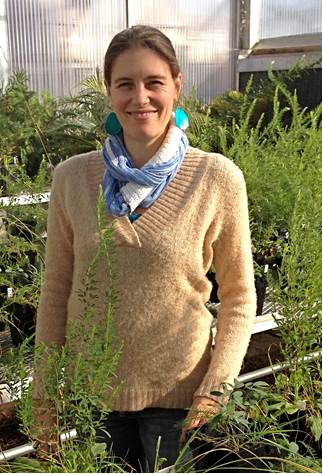
Sara Kuebbing, Ecology and Evolutionary Biology, University of Tennessee, Knoxville.
How plant-soil interactions affect current and future invasions: Field and greenhouse plant-soil feedback results for three co-occurring southeastern invasive shrubs.
Abstract: Approximately one-third of forest invaders in the southeastern United States are woody shrub species. Many forests are invaded by multiple woody shrub species and little is known about the interactions of co-occurring invasive shrubs. Plant-soil feedbacks (PSF) are one mechanism explaining successful invasions. However, we know little about PSFs between co-occurring invaders, even though understanding feedbacks might inform us about how co-occurring species interact. To study this problem, I used three naturally co-occurring invasive woody species Ligustrum sinense, Lonicera maackii, and Rhamnus dauverica to test feedbacks within and among co-occurring invaders. Using field and greenhouse experiments I ask: (1) What are the feedbacks between three co-occurring invasive woody shrubs; and (2) are results from greenhouse and field plant-soil feedback studies similar? In the greenhouse, we conditioned uninvaded field soil with one individual of each invasive species and then grew individuals of each species in conditioned soil, sterilized soil, and uninvaded forest soils. In the field, we planted 1,080 seedlings of each invasive shrub underneath the canopies of the three invaders. We analyzed final plant biomass, plant height, and number of leaves, and calculated PSFs among each invader across soil treatments. We found evidence of facilitation among invasive species, which may promote further invasion and change abundance of woody invaders. In the greenhouse, we detected no feedbacks for Ligustrum, positive feedbacks for Lonicera in conspecific-conditioned soils, and positive feedbacks for Rhamnus in soils conditioned by other invaders. When grown in uninvaded soils, Rhamnus had 50% less aboveground biomass and 35% less belowground biomass than in soils conditioned by Ligustrum, and 42% less aboveground and 12% less belowground biomass than in soils conditioned by Lonicera. In the field, we found that seedling survival in the first 15 weeks varied by species (F=34.45, p<0.001) but not by plot type (F=0.02, p=0.89). Across all plots, Rhamnus survival was 70.3% while Ligustrum and Lonicera survival was 35.8 % and 38.3%, respectively. However, in individual species models, Rhamnus survival in Rhamnus plots was 82%, which was significantly higher than in Lonicera (61%) or Ligustrum (70%) plots (F=3.20, p = 0.05). Survival of Lonicera and Ligustrum did not differ between plots.
2012
Demetra Kandalepas1 , A.E. Arnold2, G.P. Shaffer3, and W.J. Platt4. (1) Ecology and Environmental Biology, Tulane University, New Orleans, LA; (2) School of Plant Sciences and Department of Ecology and Evolutionary Biology, The University of Arizona, Tucson, AZ; (3) Biological Sciences, Southeastern Louisiana University, Hammond, LA; (4) Louisiana State University.
Hurricane effects on cryptic fungi in wetland plants.
Abstract: Ecologically important plants that maintain the hydrologic features and stability of deltaic systems are strongly affected by disturbance events such as hurricanes. Direct effects of hurricanes on plant communities are increasingly well documented, but indirect effects due to impacts on foliar fungal symbionts have rarely been evaluated. Recent work has shown that wetland plants along the US Gulf Coast harbor diverse endophytic fungi, many of which influence plant physiology and persistence. In this study we examined the short-term effects of a simulated hurricane on fungal endophyte communities within six wetland plants species in different habitat types. Specifically, we asked what are the effects of hurricane-mediated events (flooding, sedimentation, increased salinity, changes in nutrient content) on fungal endophyte diversity and composition in wetland plants? In a four-year mesocosm study we simulated a hurricane by flooding mature plants, altering soil deposition and salinity, and exposing plants to hurricane-force winds for six hours. Endophytic fungi were isolated in culture from mature leaves that emerged after hurricane treatment. We extracted total genomic DNA and amplified and sequenced a ca. 1000 basepair region of the nuclear ribosomal repeat (internal transcribed spacers and 5.8S and 28S gene) to determine endophyte diversity and composition. A total of 486 fungal isolates representing 25 species was obtained from 113 plants, including representatives of all focal species and habitat types. The simulated hurricane did not influence endophyte diversity in any species or habitat type, except within Sagittaria lancifolia, which had significantly greater diversity in controls than in plants subjected to hurricane conditions. Endophytic community composition in Taxodium distichum differed significantly after hurricane treatment vs. controls, and were strongly influenced by microhabitat conditions. Among mesocosm vessels not subjected to the hurricane, one habitat type – mesic soil, intermediate salinity, and fertilized without sediment addition — contained endophyte communities that differed from all other habitat types. After the simulated hurricane, three of the five habitat types differed significantly from each other. Microhabitat-specific and thus differential responses to hurricane-driven disturbances may produce a mosaic of fungal endophyte diversity among coastal wetland plants in Gulf Coast systems. As microhabitats change due to human activity and as hurricanes become more frequent or intense, fungal communities in wetland plants may be altered profoundly, with major implications for the ecology of deltaic systems.
2010
Elizabeth R. Matthews1 and Robert K. Peet2. (1) California Phenology Project, University of California Santa Barbara; (2) University of North Carolina.
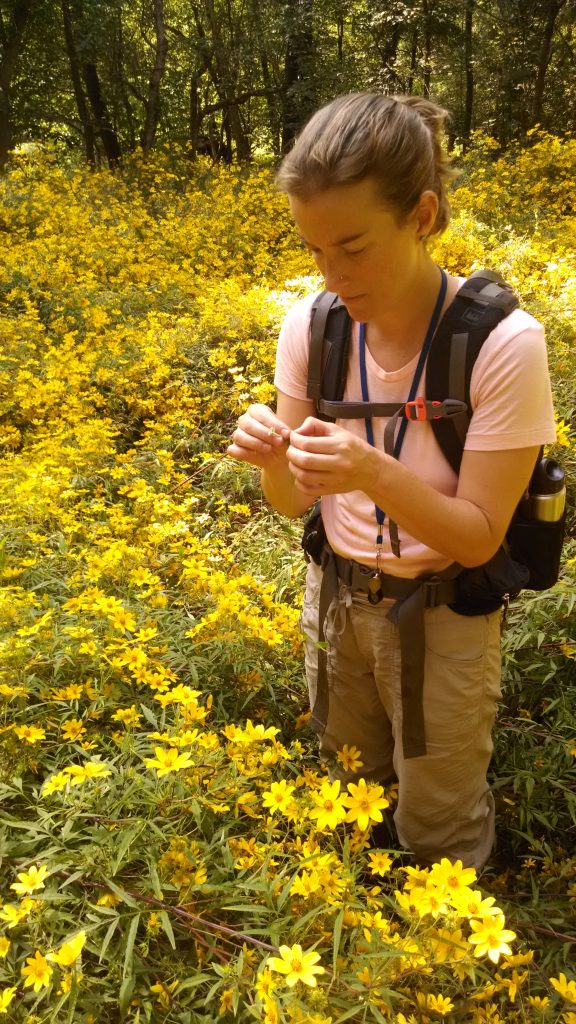
Elizabeth R. Matthews, University of California Santa Barbara.
Compositional variation in alluvial plant communities: The role of space and environment in a well-connected system
Abstract: The metacommunity concept provides a framework to link ecological processes across spatial scales, explicitly recognizing that both local and regional processes simultaneously act to shape patterns of local community composition. The relative influence of regional spatial structure and local environment is a function of both organism and habitat attributes that affect connectivity, or dispersal between local sites. Bottomland habitats provide an informative setting to examine the relationship between local and regional processes in a well-connected habitat, since bottomland habitats are by definition connected in a landscape context, longitudinally arranged along the course of a river. The hydrologic dynamics of riparian systems increase functional connectivity, as the movement of water provides an effective dispersal vector for many species. Additionally, as spatial scale increases, bottomland habitats become explicitly disconnected, once river basin boundaries are crossed, providing a useful dichotomy of scales to compare the relative influence of spatial structure and environment. We explored the role of spatial and environmental variables in explaining variation in plant community composition in bottomland habitats at these two spatial scales: across river basin boundaries and within single river basins. We used Mantel tests to investigate correlations between local vegetation composition and environmental and spatial variables and redundancy analysis (RDA) to partition variation in community composition between the two explanatory datasets. We then compared these results to other studies in the literature from both well-connected and patchy systems. We found that in alluvial habitats, environmental variables explain more variation in plant species composition and structure than does spatial structure . Each of our analyses supported this same conclusion. When we used in-stream distance instead of Euclidean distance for Mantel tests, correlation between vegetation composition and geographic distance further declined. RDA results indicate that local edaphic conditions explain the largest portion of total variance explained (21% of total variance). In addition, the explanatory power of local environment increases when restricted to the scale of a single river basin where habitat connectivity and functional connectivity are highest. Our results indicate similar explanatory power of environmental variables as found in other contiguous forested systems (mostly tropical forests), but still fail to account for a considerable portion of the variation in plant community composition (RDA residuals account for 70% of variation in abundance data).
2009
Emily Farrer1 and Deborah E. Goldberg2. (1) Environmental Science, Policy & Management, UC Berkeley, Berkeley, CA; (2) Ecology and Evolutionary Biology, University of Michigan, Ann Arbor, MI.

Emily Farrer, Environmental Science, Policy & Management, UC Berkeley.
Plant-soil feedback in the field: A test in a perennial grassland.
Abstract: Plant-soil feedbacks have recently received considerable attention for their potential role in influencing community structure and dynamics. However, most empirical studies are performed as greenhouse pot experiments under very controlled conditions and measure only individual plant growth responses. Thus it is unclear whether the feedbacks measured in these experiments operate and drive population and community dynamics in the field, in which many other processes undoubtedly occur. In this study, we test net plant-soil feedback in the field, which incorporates feedback via soil nutrients, moisture, light, soil pathogens, and mycorrhizae and integrates effects through nontrophic as well as resource-uptake (competition) mechanisms. We test the two components of feedback, species effects on the environment and species responses to the environment, in a xeric perennial grassland using environmental measurements and a two year transplant experiment in natural field monocultures. For species effects, we focus on abiotic soil characteristics (nutrients and moisture) because these are the most limiting in this dry, nutrient poor system. For species responses, we measure both population (ramet production) and individual growth. We hypothesize that plants in this system produce negative feedbacks, because previous work suggests intraspecific interactions are more negative than interspecific. The four dominant plant species in this community are associated with different suites of environmental characteristics, which are also distinct from plots with no plants (bare) or with reindeer lichen (another dominant in the system). Specifically, species differ in soil characteristics such as soil moisture, ammonium and nitrate levels, and nitrogen mineralization and nitrification rates, and also in aboveground environmental characteristics like litter biomass, litter height, and light levels. Species exhibit some differential responses to these environments both at the population and individual plant level. Overall, species responses suggest weak negative feedbacks occur but are not pervasive in this system. At the population level, Danthonia transplants produced fewer stems (ramets) in conspecific plots, but none of the other three species’ populations were affected by plot identity. At the individual level, Hieracium plants had fewer leaves in conspecific environments, and Carex and Hieracium grew taller in one of the heterospecific environments. Thus, similar to many greenhouse experiments that test only nontrophic feedbacks, this study shows that net feedbacks combining nontrophic plus competitive mechanisms are also negative to neutral. The negative feedbacks found here can contribute to the coexistence of the dominant species in this system.
2008
David Harris
When will species homogenize or differentiate communities? An occupancy-based null model of the effects of species invasions. 2008 ESA meeting in Milwaukee. The paper was co-authored by Kevin G. Smith, Washington University in St. Louis.
Abstract: Invasive species’ potential to homogenize biotas contributes to their status as major threats to biodiversity. Though more than a dozen homogenizing and differentiating mechanisms have been proposed, they have not been incorporated into a unifying framework and null expectations are only beginning to be formulated. Empirical studies of homogenization have also given conflicting results, indicating that invaders’ effects are context-dependent. Previous studies have demonstrated a connection between occupancy rates and similarity, with ubiquitous species homogenizing landscapes and idiosyncratic ones differentiating them, but this relationship has not yet been put in precise terms and is thus sometimes misinterpreted. Scientists have also noted that changes in similarity depend on initial similarity, but explanations of this pattern have yet to be formalized. Using an occupancy-based null model of community assembly, we incorporate both of these observed patterns into predictions about homogenization and differentiation and extend those predictions as occupancy rates change over time. Our model predicts that as invasive species proceed from low occupancy rates to high occupancy rates, there will be a transition from a net differentiating effect to a net homogenizing one. The threshold occupancy rate at which this transition occurs is equal to the pooled occupancy rate of the other species in the community. Thus, highly differentiated landscapes with many rare or endemic species will have low thresholds and will be most strongly homogenized by invasion. The model also suggests that more speciose communities (including those defined at a coarse spatial grain) will have more “inertia” against both homogenization and differentiation than more depauperate communities. Though this null model omits important biological complexity, its predictions give a baseline against which real invasions can be measured and may help clarify our thinking about similarity metrics and homogenization while indicating which landscapes are most vulnerable and how similarity might change over time.
2007
Charles Price

Charles Price, Georgia Institute of Technology.
Allometric covariation in botanical form and function presented at the 2007 ESA meeting in San Jose. The paper was co-authored by Brian J. Enquist, University of Arizona, and Van Savage, Harvard Medical School.
Abstract: Recent advances in metabolic scaling theory have highlighted the importance of vascular network geometry in understanding the integration and scaling of whole-plant form and function. Additional work has demonstrated general scaling relationships for many leaf traits. However, it is unclear if a common theoretical framework can reveal the general rules underlying much of the variation observed in scaling relationships at the whole-plant and leaf level. Here we present an extension of the general model introduced by West, Brown and Enquist, that predicts scaling relationships in whole plants and leaves. Specifically, the model shows how the exponents describing how whole plant and leaf dimensions (surface area, length and diameter) should change with increasing mass (or with one another) as plants and leaves meet the demands of network flow in varying environments. As a result, our expanded network model predicts a highly constrained continuum of biological exponents that covary according to specific quantitative functions. Compilations of allometric data for a wide variety of plant taxa strongly support the extended models predictions. Together, our results (i) underscore the importance of network geometry in generating the diversity of allometric scaling relationships in biology, (ii) support the hypothesis that while selection has primarily acted to minimize the scaling of hydrodynamic resistance and, (iii) additional selection pressures for alternative branching geometries apparently govern much of the observed co-variation in intraspecific and interspecific scaling exponents. Further, our model provides a general theory to understand the origin and variation of many allometric trait correlations within complex integrated phenotypes.
2006
Jeffrey Lake

Jeffrey Lake, University of Georgia, Athens.
Community assembly in a temperate forest tree community: Testing limiting similarity, environmental filtering, and functional equivalence with leaf functional traits co-authored with S.P. Hubbell and L. Borda de Agua, and presented at the 2006 ESA meeting in Memphis.
Abstract: Community niche structure and limiting similarity have seldom been tested in the context of plant communities, particularly in a size-structured forest system. Recent advances in niche metrics, such as Mouillot et al’s (2005) group of nonparametric indices, provide new opportunities to test community niche structure using continuously distributed functional trait values. We propose an index of community niche overlap based on Mouillot et al’s nonparametric indices, but that weights species for abundance, biomass, and other issues influencing the importance of a species within a community. We then apply these methods at a variety of spatial scales to a southeastern US piedmont forest at Thompson Mills, GA. Leaf functional traits, including specific leaf area ( SLA ), leaf nitrogen content (LNC), carbon:nitrogen ratios (C:N), as well as a number of measures of leaf morphology, are used in the tests of trait overlap. Each hypothesis of community assembly would predict different patterns of trait overlap. 1. Limiting similarity would lead to low trait overlap, particularly at smaller spatial scales where most cross-species interactions occur, and would decay over larger spatial scales. 2. Environmental filtering would lead to high levels of overlap at small scales, decaying as the environment changes. 3. Similar measures at all spatial scales would be consistent with predictions of neutrality. While results are mixed, within this community, we found a larger degree of overlap in most traits at all spatial scales than would be predicted by classical niche theory, suggesting a stronger role for habitat filtering and a degree of neutrality, particularly in morphological traits.
2005
Paul Henne
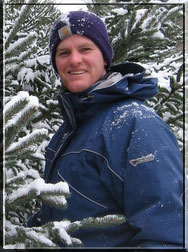
Paul Henne, University of Illinois, Urbana.
Spatial and temporal response of forest communities to variation in lake-effect snow in northern Lower Michigan co-authored with F. S. Hu and presented at the 2005 ESA meeting in Montreal.
Abstract: Reductions in snow extent and duration are expected in northern temperate ecosystems in response to global warming. However, the ecological impacts of such changes remain uncertain. The Great Lakes region provides a unique opportunity to examine community response to snowfall variability because it contains fine-scale heterogeneity of forest communities, and a strong gradient in annual snowfall due to the occurrence of lake-effect snow (LES). We coupled GIS and lake-sediment analyses to examine how spatial and temporal variations in LES interact with glacial landforms to impact forest communities in northern Lower Michigan. GIS analysis revealed the spatial correlation of upland tree species with LES. Today, northern hardwoods (e.g. Fagus, Acer) dominate on all landforms (e.g. outwash, till) within the lake-effect snowbelt (SB) but are restricted to fine-textured soils in nearby areas outside of the SB. We evaluated this vegetation-snowfall relationship during the Holocene by comparing and pollen records from two SB and two non-SB lakes. To control for the influence of landform one lake in each snowfall regime is situated on outwash, and the other on till. In both the SB and non-SB a stepwise decline in occurs circa 7000BP in response to a regional increase in moisture. However, around 5000BP, becomes consistently (0.5-1‰) more depleted within the SB relative to the non-SB. The larger magnitude of the decline within the SB probably reflects the input of LES because LES results from depleted vapor from the Great Lakes. Principle component analysis of pollen percentages reveals two distinct vegetation types in the past 7000 years: a xeric type dominated by Pinus, and a mesic type dominated by northern hardwoods. At both SB sites a clear shift from xeric to mesic vegetation occurs circa 5000BP. A similar shift never occurred outside the SB. Differences in vegetation associated with snowfall (SB vs. non-SB) are far greater than differences due to landform (till vs. outwash). These data indicate that snowfall exerts a dominant influence on the ecological processes controlling spatial and temporal variation in forest communities around the Great Lakes.
2004
Jason McLachlan

Jason McLachlan, Duke University.
The importance of small populations in the postglacial dynamics of eastern forests, co-authored by J. S. Clark and P. S. Manos of Duke University and presented at the 2004 ESA meeting in Portland.
Abstract: The postglacial dynamics of temperate trees are understood primarily based on paleoecological range reconstructions. These reconstructions suggest that many eastern North American species expanded rapidly from glacial refuges in the south during the early Holocene. The concept that trees are able to accommodate rapid environmental change through range shifts has subsequently been widely accepted by ecologists and conservation biologists. We show that pollen and macrofossils in modern sediments poorly represent the ranges of species when they are rare. Fossil data, by extension, run the risk of grossly underestimating the past ranges of species that are rare over much of their range. We reconstructed the postglacial history of a suite of common eastern tree species based on genetic data that are independent of the fossil record. We surveyed chloroplast DNA variation throughout the modern distribution of these species. Our molecular data show that fossil based reconstructions have indeed underestimated the importance of small populations in the dynamics of postglacial recolonization. Combining fossil and molecular data leads to the following revised scenario of postglacial spread: The late glacial ranges of many species was extensive south of the Laurentide Ice Sheet, though population densities were low everywhere. Deglaciated terrain was colonized by advance populations near the ice sheet, rather than by rapid long distance migration from southern refuges. Northern populations of these species today are consequently more genetically diverse than equivalent European populations, which experienced more severe postglacial bottlenecks. Projections of contemporary climate change indicate that these populations will have to spread more rapidly in the near future than did equivalent populations during the early Holocene.
2003
Rachel J. Collins (First Recipient)

Rachel J. Collins, University of Pittsburgh.
Do succession models predict the right pattern for the wrong reason: shade vs. herbivore tolerance? Co-authored by Walter Carson of the University of Pittsburgh.
Abstract: Succession models typically predict the replacement pattern of species following disturbance. One of the most prominent models, the shade-tolerance model, uses species-specific tolerances of seedlings to low understory light conditions as the mechanism to predict species replacement. A second model uses shade tolerance in combination with the timing of the disturbance during succession (i.e., a stage-dependant model) as the mechanism for predicting species replacement. Both of these models are based on resource-species interactions and ignore the potential effects of herbivores in determining successional trajectories. White-tailed deer populations are at historically high levels in many areas. By neglecting the effects of browsing, these models may either fail to predict successional trajectories or make the correct prediction for the wrong reason (i.e., shade tolerance instead of herbivore tolerance). We experimentally tested the predictions of these two models with three types of disturbances: canopy gaps, understory fire, and a combination of gap and fire at two levels of herbivory. At the Westvaco Research Forest in northeastern West Virginia, we have established 64 plots (400 m2) where we have permanently tagged, identified, and measured nearly 17,000 seedlings, saplings, and adults of 26 species of trees. In the absence of deer herbivory, the shade-tolerance model correctly predicted the dominance of shade-intolerant species (i.e., pioneers) after both fire and canopy gap formation. In the presence of deer herbivory, however, shade-tolerant species (i.e., late succession) dominated after disturbances. The stage-dependant model did not consistently predict the dominant species. Herbivory is changing these successional trajectories, truncating succession, and preventing pioneer species from dominating during early succession. Thus, under current conditions of overabundant deer populations that exist throughout much of eastern North America, forest succession models that fail to explicitly incorporate herbivory or tolerance to herbivory will not consistently predict species composition and successional trajectory in forests.
